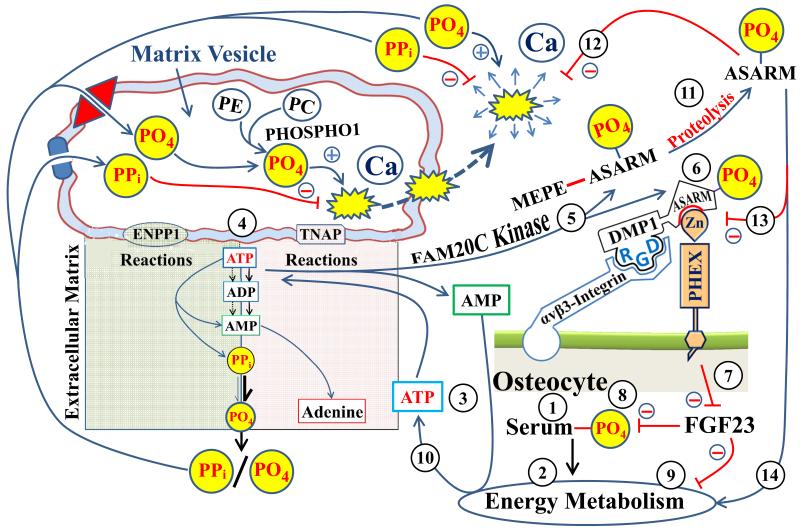Figure 2.
Scheme illustrating the matrix vesicle (MVP) mineralization pathway and the PHEX/FGF23/DMP1 & ASARM extracellular matrix mineralization pathway (FAP). The encircled numbers refer to the following explanation of the model: (1) changes in serum phosphate (PO4) will impact energy metabolism (2) and ATP production (3 & 10). ATP levels are pivotal for the generation of pyrophosphate (PPi) and PO4 by two key matrix vesicle (MV) membrane bound phosphatases (ENPP1 and TNAP; see text and 4). PPi inhibits mineralization and PO4 is a required substrate both are transported into the MV by specific transporters (Pit and ANK; depicted by the blue cartouche and red diamond). The ratio of PPi/PO4 is key for mineralization to proceed normally. Within the MV, PHOSPHO1 also generates PO4 from phosphatidylethanolamine (PE) and phosphatidylcholine (PC) providing additional substrate for the growth of nascent MV hydroxyapaptite (depicted by yellow explosion cartoon). FAM20C kinase (5) also utilizes ATP to phosphorylate (6) ASARM-motif (DMP1) and ASARM-peptide (MEPE). Phosphorylation of DMP1 ASARM motif is requisite for the formation of a PHEX/DMP1/α5β3-integrin complex on the surface of osteocytes (6). This results in down regulation of FGF23 (7). This in turn affects renal PO4 handling and energy metabolism (8 & 9). A feedback is provided by proteolysis and release of ASARM peptides (11) that inhibits the PHEX/DMP1/α5β3-integrin complex (13). FGF23 increases and ASARM-peptides inhibit mineralization and energy metabolism (12 & 14). The ATP/FAM20C component (3, 5 & 10) provides a nexus between the MV, FAP and energy metabolism pathways.

